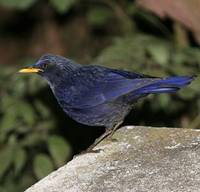|
| 질의: White perch | 결과: 178번째/186 | |
Blue Whistling-Thrush, Doi Inthanon

| 해상도: 314x301
파일크기: 14558 Bytes
등록시간: 2008:03:19 15:12:53
|
Birdtour Asia Thailand Custom Tour December 2006
Blue Whistling-Thrush, Doi Inthanon
We arrived shortly after dawn at the salt-pans by the small town of Pak Thale, which has recently played host to a tiny wintering population of the enigmatic Spoon-billed Sandpiper. Diligent searching eventually paid dividends as we were soon watching this unique species as it actively fed; its amazing spatulate bill moving side-to-side deep in the mud. It wasn’t long before another bird was feeding along side it, then a third, and a forth, and eventually a total of 5 of these charming birds feeding close together at ranges down to 20 metres in amongst large numbers of Red-necked Stints and Broad-billed Sandpipers. Other species seen during the morning including a rather obliging Ruddy-breasted Crake, seemingly unable to find anywhere to hide, large numbers of other shorebirds were predominately Lesser Sand-plovers, with small numbers of such eastern gems as Long-toed Stints and Pacific Golden-Plovers. As we moved inland, with Asian Pied Starling, Plaintive Cuckoo, Black-capped Kingfisher, a female Pied Harrier and Eastern Marsh Harriers dotting the roadside, we eventually reached our destination – Kaeng Krachen National Park, a quite wonderful, wild, national park nestled close to the Burmese border. The 15km drive along the entrance road through the deforested, scrubby hillsides was relatively quiet, but as soon as we parked up the birds began to perform. Our first bird proved to be a vocal Sultan Tit, with its yellow crest glowing in the sun, Blue-winged Leafbirds fed nearby, then the call of a Blue Pitta was heard in the nearby undergrowth and within 5 minutes we were enjoying close views of this dazzling forest jewel as it hopped in a circle around us before posing on the trail in front of us - a great start to the afternoon. A Grey Peacock-Pheasant was then heard from the slope above us; a short climb up the bank and some gently persuasion soon brought this fabulous galliform scuttling towards us and we were treated to point-blank views as the bird proceeded to call for several minutes before wandering slowly back into the undergrowth in response to another distant bird. Returning to the trail a male Orange-breasted Trogon appeared close to the road then the cooing calls of Thick-billed Green-Pigeons overhead drew our attention to a huge fruiting tree complete with a pair of huge Great Hornbills. Amazing views were had through the scope as the pair fed quietly in the lower canopy; quite how they can deal with such tiny fruits with their huge ivory-like bills is quite amazing! As dusk fell, the distinctive calls of Great Eared Nightjars started, and we were treated to great views as a single, tailless, bird hawked harrier-like overhead. A short while later a Brown Boobook began to call nearby and soon responded to our imitations by swooping in and landing right beside us allowing great views in the spotlight. We carried on along the track in search of our main prize and after a short while we eventually heard the subtle calls of a White-fronted Scops-Owl, one of the rarest and least known of Asia’s owls. Although it took us the best part of half an hour before the bird eventually showed, the effort was worthwhile as it sat just 2 metres above the ground perched on an open perch in the spotlight for a short while as it moved its head a full 180 degrees in search of its prey. Once again we had fabulous views of the species, keeping up our 100% record of locating the species here.
|
^o^
동물그림창고 똑똑전화 누리집
^o^
|
|